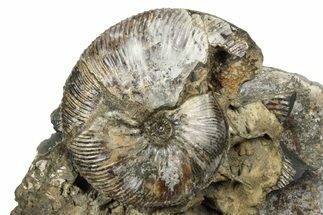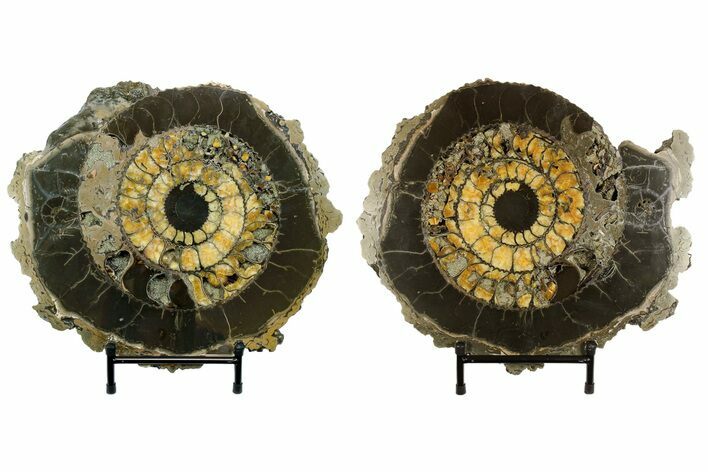This Specimen has been sold.
14.4" Cut & Polished Ammonite (Speetoniceras) Fossil With Druzy Pyrite
This is a large, 14.4" (each) wide Speetoniceras ammonite fossil from the Lower Cretaceous deposits of the Volga River in Russia. It has been cut in half and polished, revealing the inner chamber structure. The chambers are filled with a mixture of calcite (simbircite?) and druzy pyrite crystals. There is an additional cross section of an ammonite fossil within one of these chambers. Much of the pyrite that surrounded this ammonite has been left over its exterior. This is a gorgeous display piece and it comes with a stand to facilitate aesthetic presentation of each half.
Under both short and long-wave UV, the calcite fluoresces a white color. There has been some restoration and repair to the ammonite. Several cracks have been repaired and filled on the backside and it's likely some of the pyrite has been added.
Under both short and long-wave UV, the calcite fluoresces a white color. There has been some restoration and repair to the ammonite. Several cracks have been repaired and filled on the backside and it's likely some of the pyrite has been added.
About Ammonites
Ammonites were ancient marine cephalopods, similar to today's squids and octopuses, but with a defining feature: their distinctive, tightly coiled spiral shells. These shells, resembling those of modern nautiluses, served as both a protective home and a buoyancy aid, allowing ammonites to navigate the prehistoric seas with ease. First emerging around 240 million years ago in the Triassic Period, ammonites thrived for over 175 million years, adapting through numerous forms and sizes. As predatory creatures, they likely fed on smaller marine organisms, using their tentacles to capture prey. However, their long reign came to an end 65 million years ago at the close of the Cretaceous, coinciding with the mass extinction event that also eliminated the dinosaurs.
Ammonites were ancient marine cephalopods, similar to today's squids and octopuses, but with a defining feature: their distinctive, tightly coiled spiral shells. These shells, resembling those of modern nautiluses, served as both a protective home and a buoyancy aid, allowing ammonites to navigate the prehistoric seas with ease. First emerging around 240 million years ago in the Triassic Period, ammonites thrived for over 175 million years, adapting through numerous forms and sizes. As predatory creatures, they likely fed on smaller marine organisms, using their tentacles to capture prey. However, their long reign came to an end 65 million years ago at the close of the Cretaceous, coinciding with the mass extinction event that also eliminated the dinosaurs.
SPECIES
Speetoniceras sp.
LOCATION
Volga river, Ulyanovsk region, Russia
SIZE
Each half 14.4" wide
CATEGORY
SUB CATEGORY
ITEM
#175077
We guarantee the authenticity of all of our specimens.
 Reviews
Reviews

























